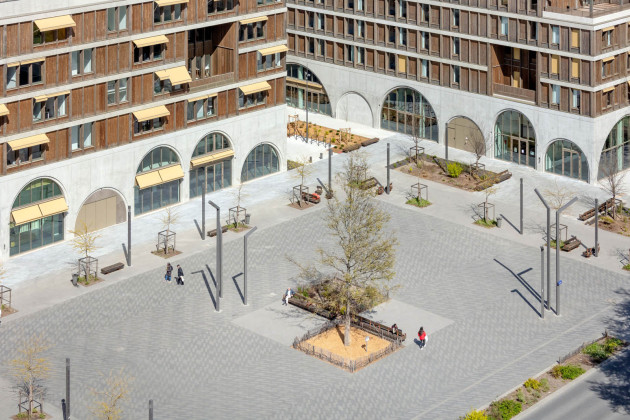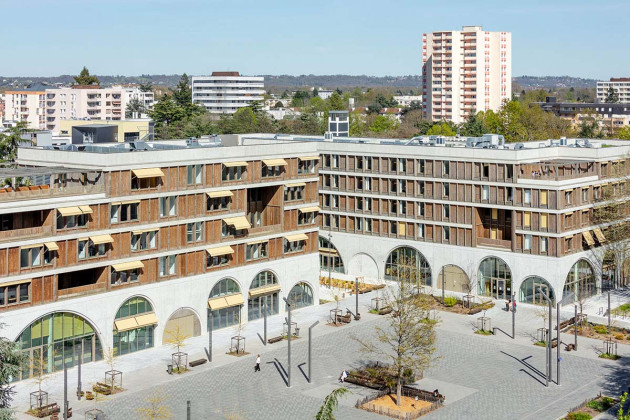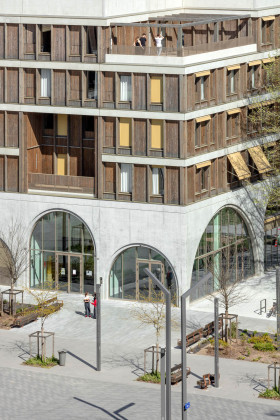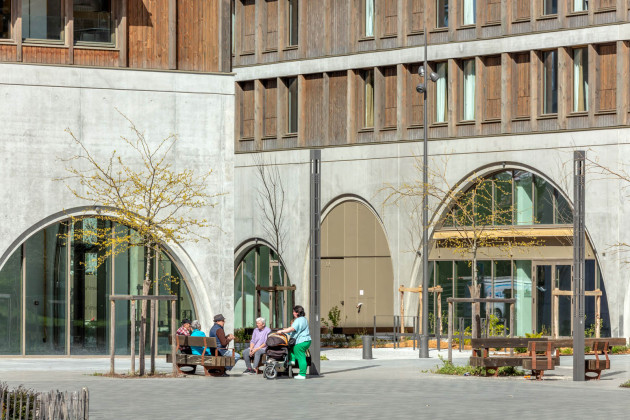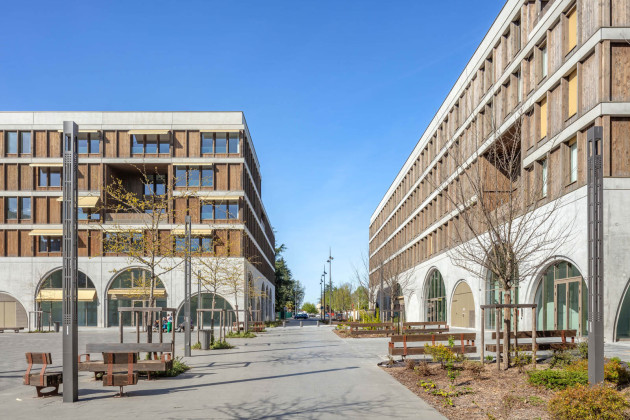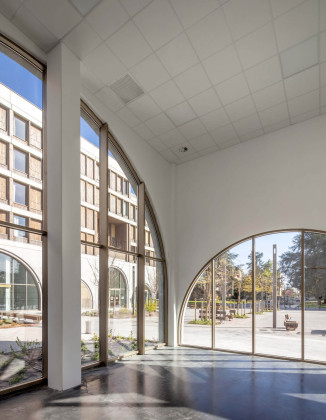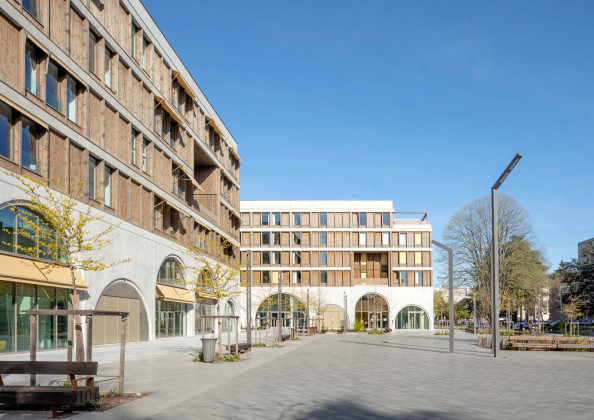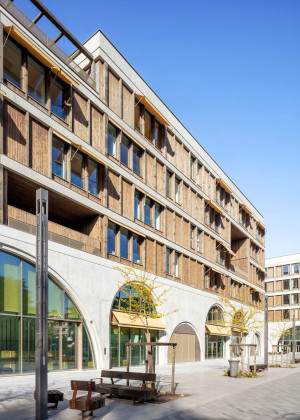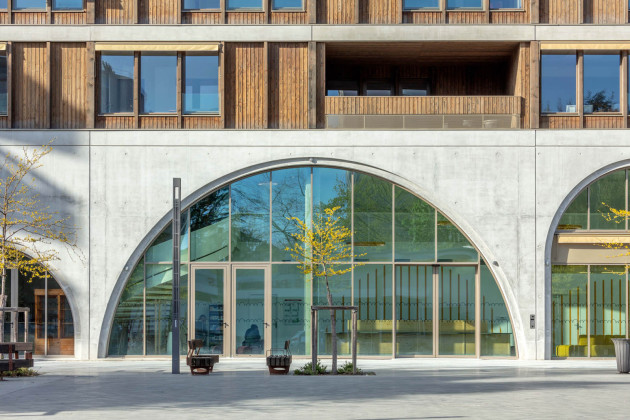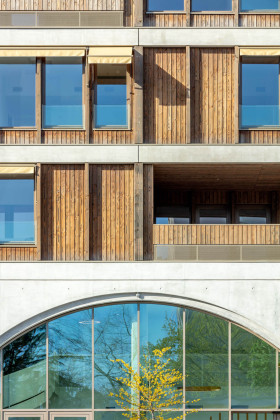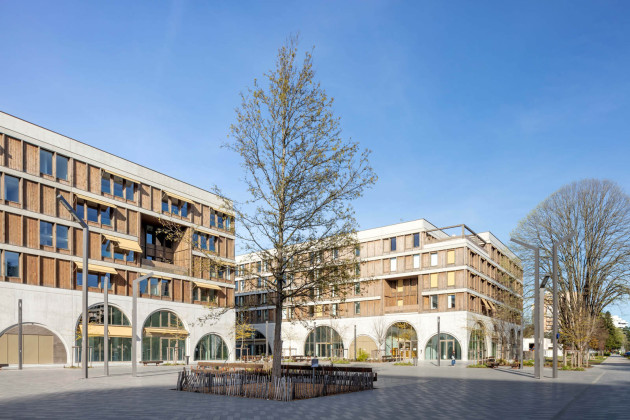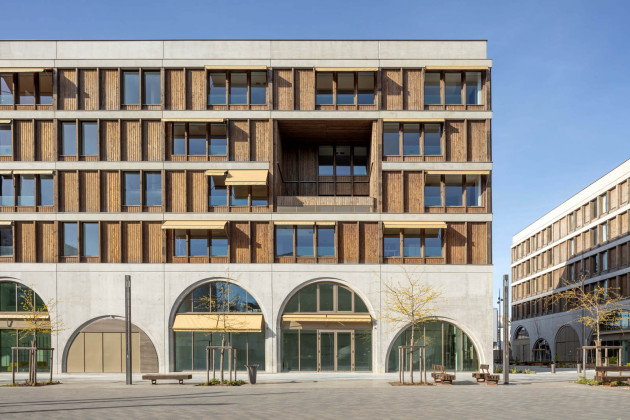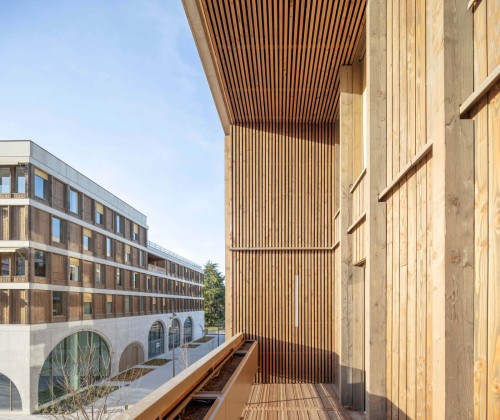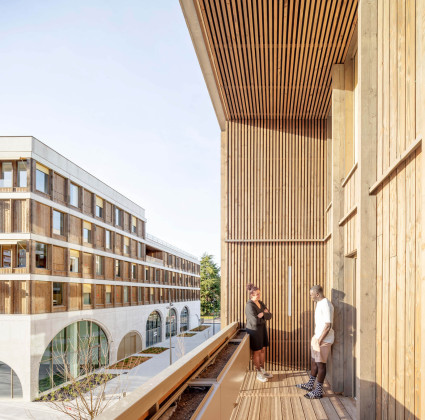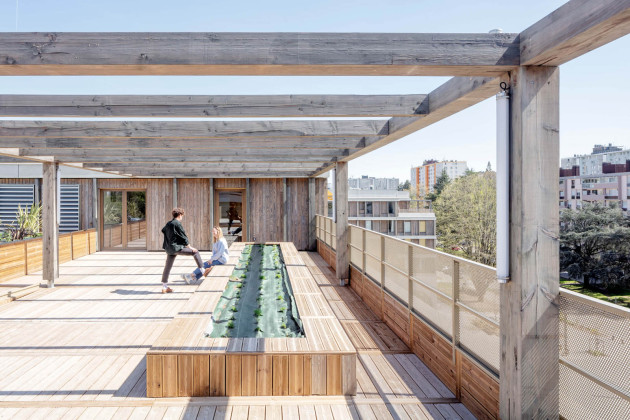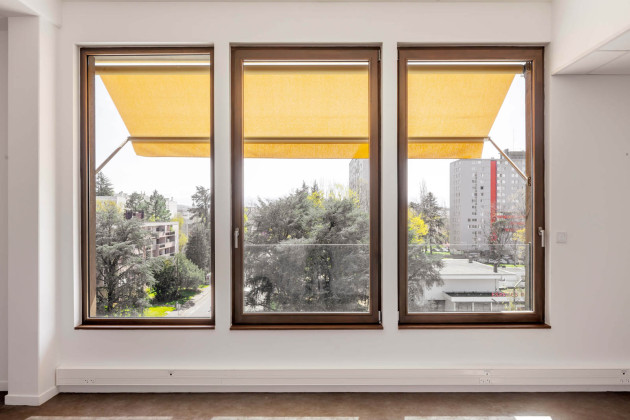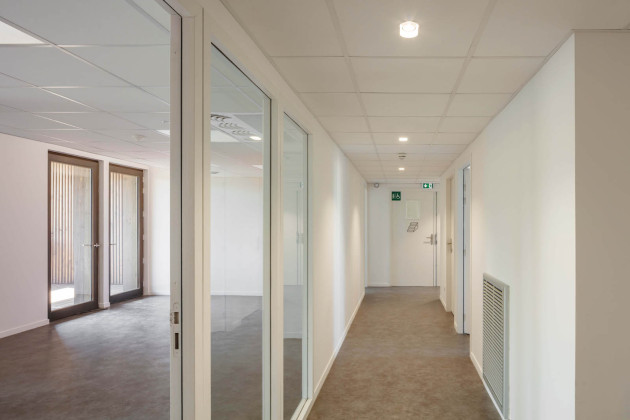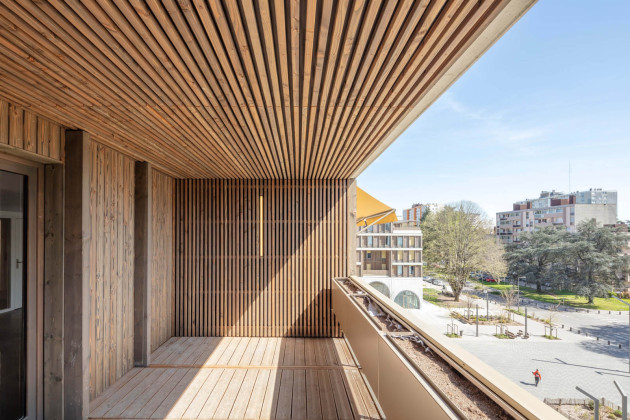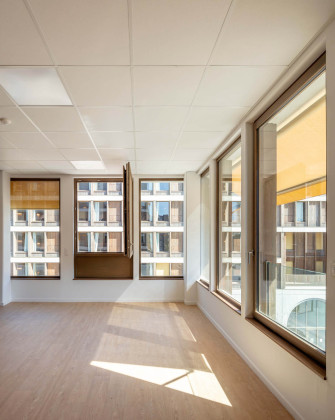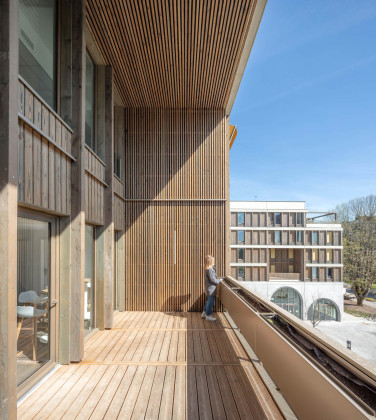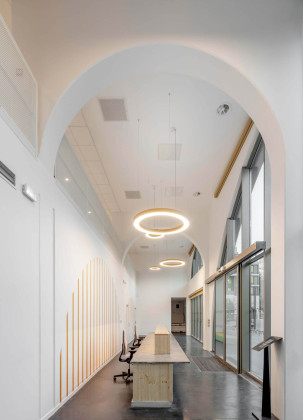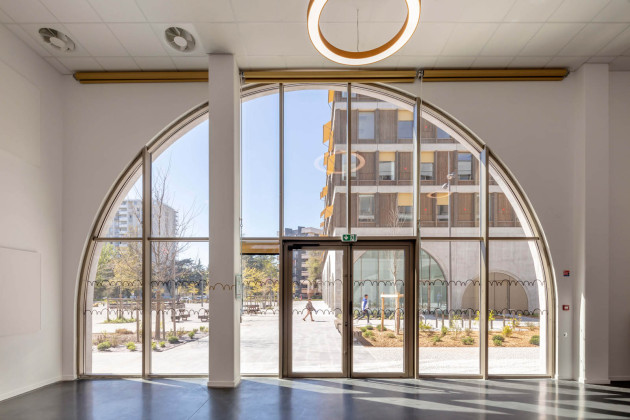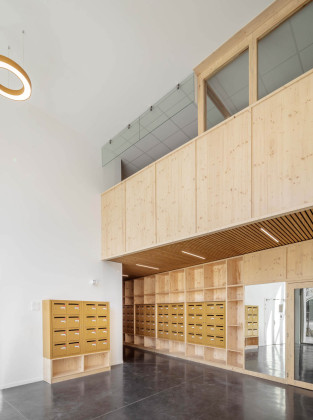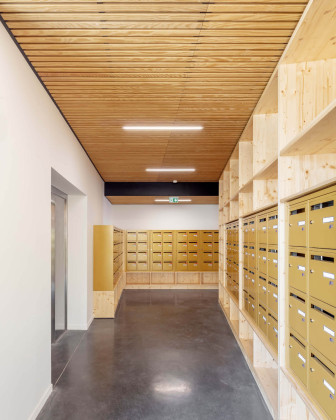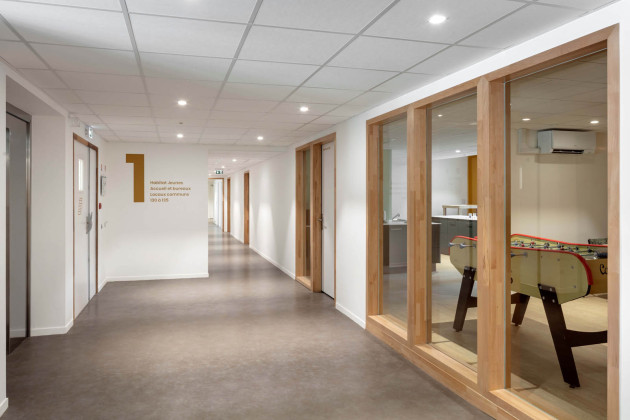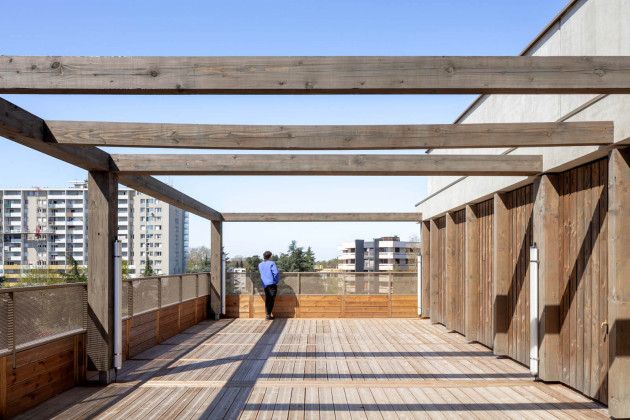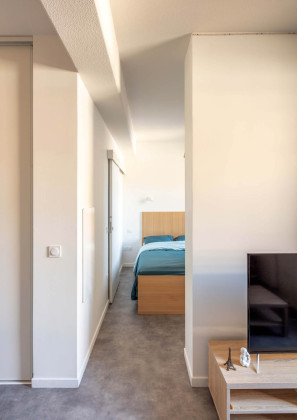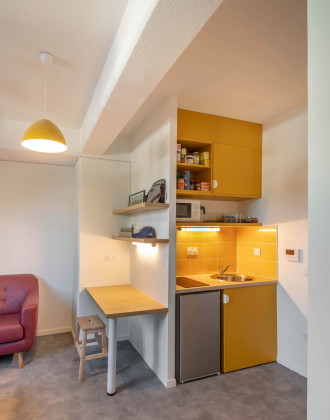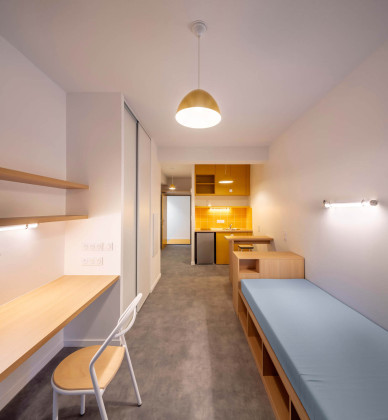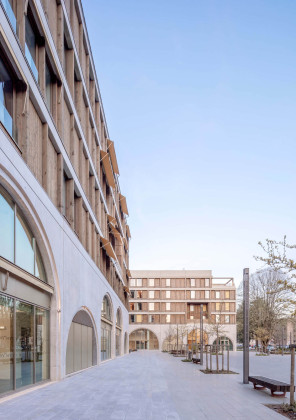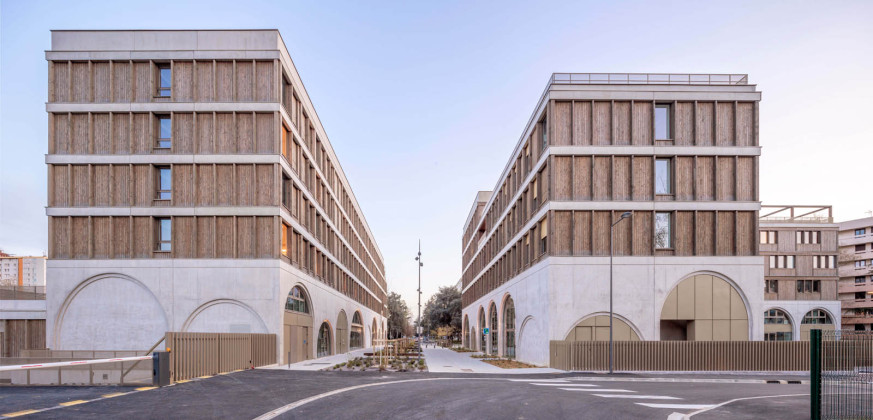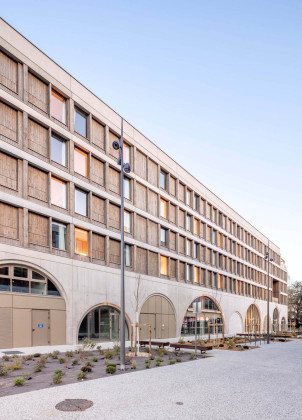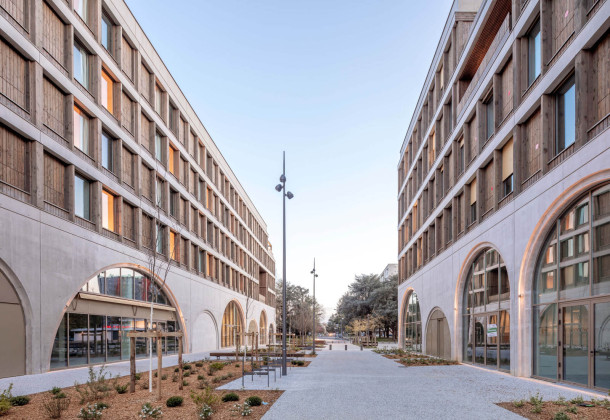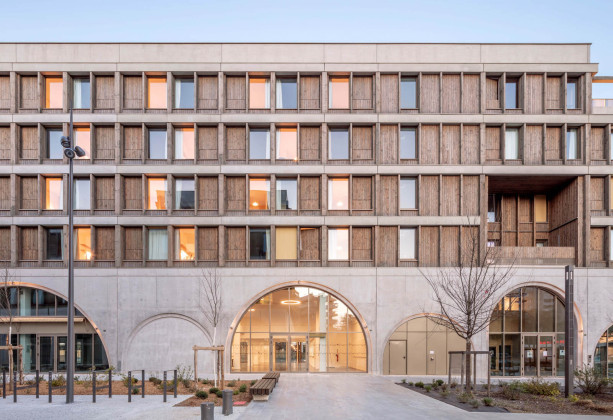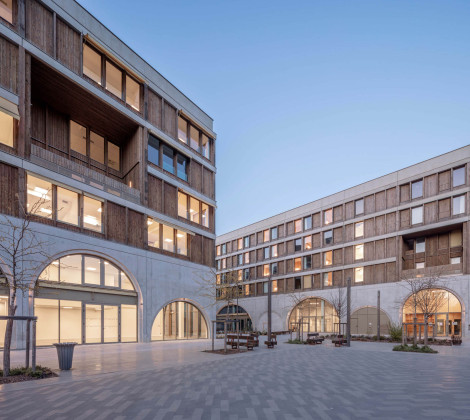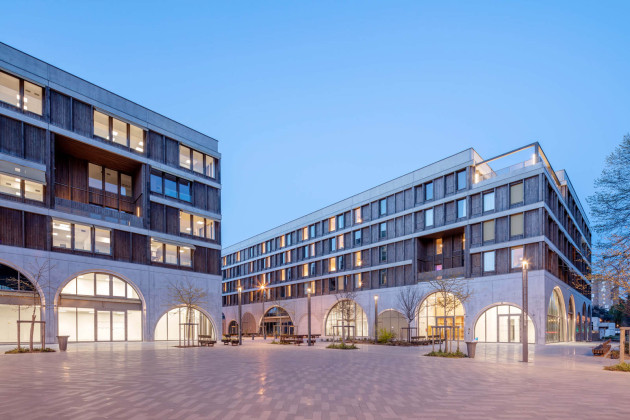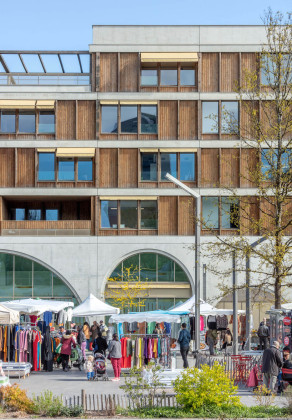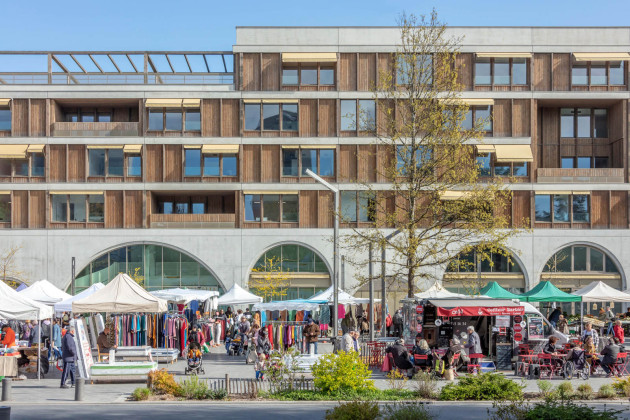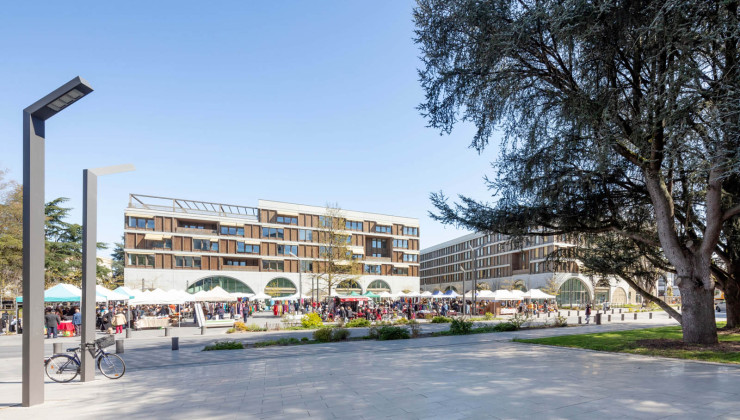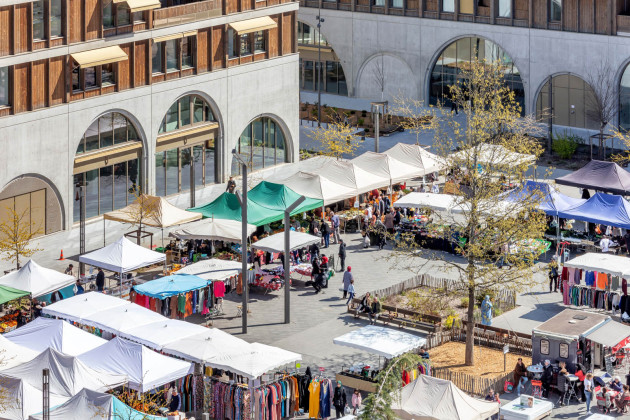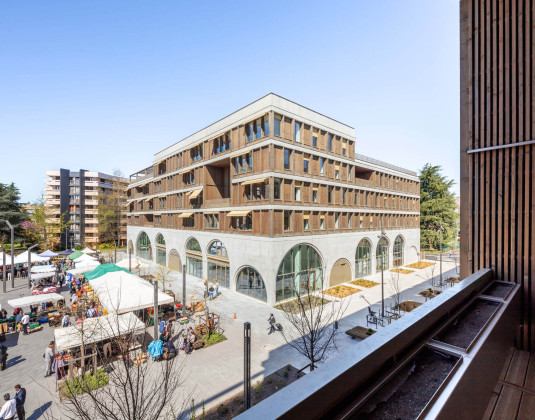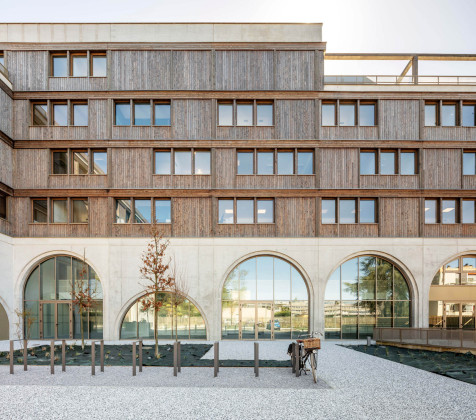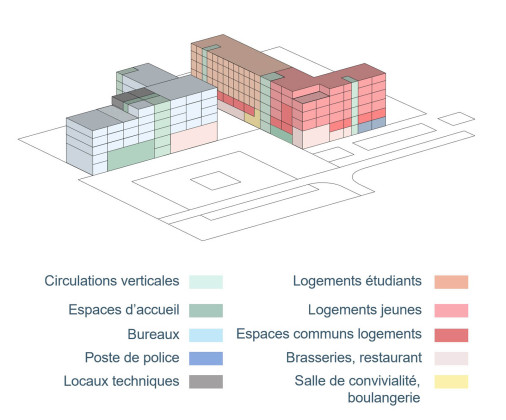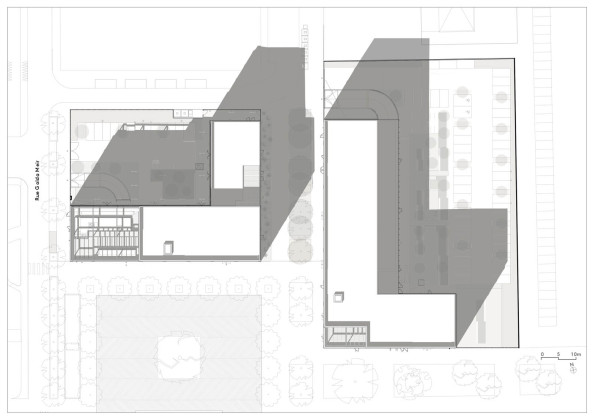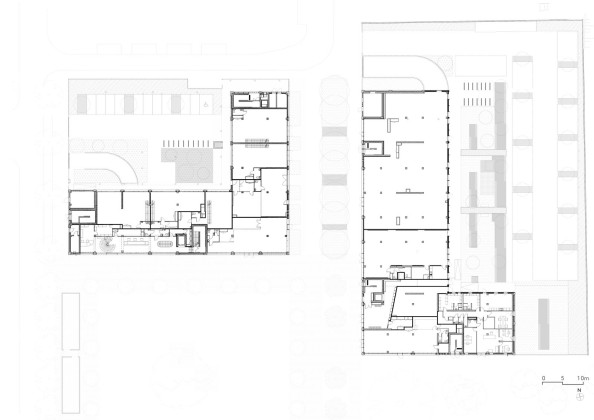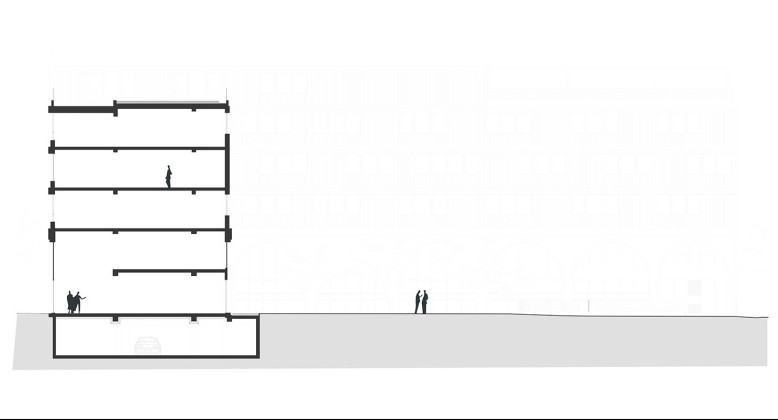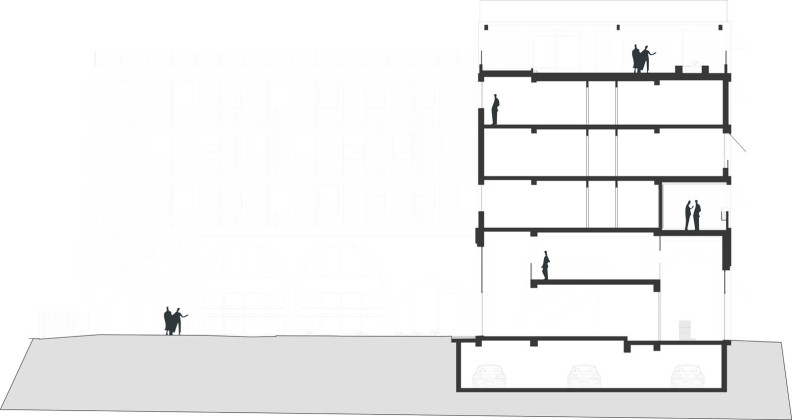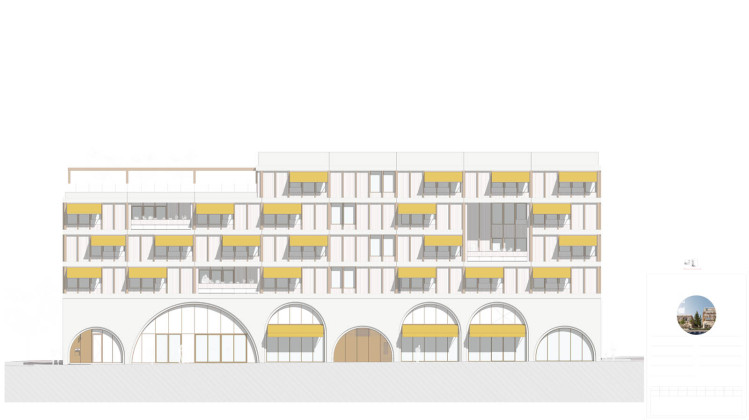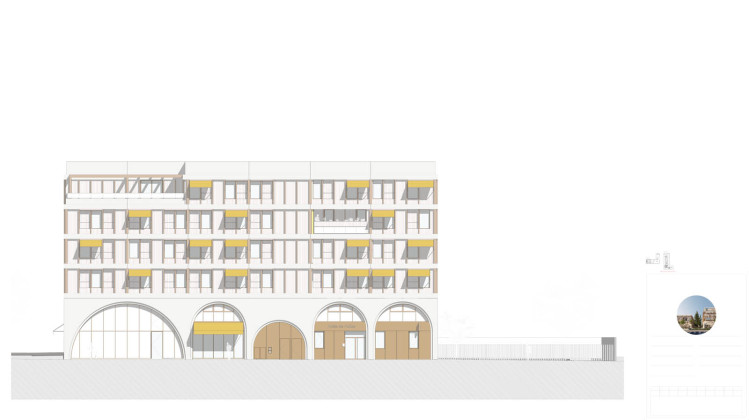Laherrère Center
Laherrère Center project, designed by CoBe Architecture & Paysage in collaboration with WEEK, is located in the city of Pau, France. The office describes the project as follows:
On the Laherrère Square in Pau, France, in the heart of the Zaragoza district, CoBe’s architects, urban planners, landscapers, designers and site managers, in co-contracting with WEEK agency, just built two 11,210 m2 buildings of an ambitious program led by Pau Béarn Habitat.
Being at the same time a place of life, work, professional training and economic development, the Laherrère center contributes to the development of the Zaragoza district by creating a large offer of housing for students and young workers, office and training spaces, craft premises, as well as local shops and services.
Spread over two buildings, the project has a mixed materiality made of wood, concrete and glass, and is part of a global sustainable development approach combining bioclimatic design, bio-based materials, and energy performance.
A Changing Context
The Saragosse district in which the project is built was designed in the 1950s and 1960s. Its urban renewal project has identified it as a territory in great social fragility but with a very favorable urban position, close to the city center of Pau. Saragosse is now the most important social housing district of the urban area with about 14,000 inhabitants, and is subject to intrinsic fragilities: its urban planning is characteristic of the big housing estates era, the low rents it offers make it a solution for people in precarious situations, and the supply of local trade and equipment is very fragile.
Faced with this observation, the State, with the ANRU (National Agency for Urban Renewal) and the city of Pau, has decided to invest heavily in this district alongside the social landlord Pau Béarn Habitat. Renovations, demolitions and landscaping projects aimed at requalifying collective spaces at the foot of buildings are scheduled until 2027.
The city of Pau is investing heavily in the development of bike paths, public transport and in the creation of a district heating network that allows the sector to be labeled «EcoDistrict». The construction of the Laherrère center is one of the priority axes of the urban renewal program of the Saragosse district. It is based on the general idea of creating two buildings: one to respond to the problem of housing for students and young workers and another for companies or associations mainly focusing on integration through employment, with services and shops on the ground floor.
In the heart of the district was located an old hospice unoccupied and in very poor condition. The city proceeded with its demolition and wanted to build a qualitative real estate complex on the land left free, energizing, and attractive both for the inhabitants and for the outsiders who will come to work and meet there. It is in this context that the design competition for the creation of the Laherrère center was launched in 2018, won by CoBe (main architect) and WEEK (co-contractor).
Living in The Square
The primary intention of the project was to constitute a real living space, on the model of a village square, like the market that the site has hosted since the beginning of the work. The two L-shaped buildings, firmly anchored on Laherrère square, both adopt the same volumetry and the same materiality composed of wood and concrete.
Mixed Materiality
On the two levels of the ground floor their structure rises in elegant proportions with low carbon raw concrete arches poured on site. Some arches sometimes rise on two levels and are inspired by the local historical architectural language, while structuring the new square and promoting the reactivation of neighborhood life. On the five upper floors that make up the two buildings, the expression becomes lighter by sporting wood-frame facades with wood fiber insulation, wood joinery and warm-colored blinds, and reveals the rich and varied programming of the project.
The frame of the façade is made of pectinated fir from forests of the Pyrénées Atlantiques and Hautes-Pyrénées, while its coating is made of pre-grayed Douglas fir from the Auvergne Rhône Alpes region. The joinery of the building is produced from Scots pines from Corrèze. Thus, all the wood species constituting the project come from French forests located less than 450km from the site.
Mixed Program
Being at the same time a place of life, work, professional training and economic development, the Laherrère pole contributes to improving the living environment of the inhabitants of the Saragosse district and to meeting a maximum of needs. The post and beam construction system put in place, in addition to its frugal dimension, makes it possible to accommodate a wide range of programs within the same project, and makes it possible to anticipate a possible evolution of this programming during the life of the building.
Thus the real estate complex includes:
- A housing hub with 116 student housing units managed by the CROUS (social organization for students) and 60 housing units for young workers managed by the Habitat Jeunes Pau Pyrénées association with shared common spaces, in connection with the professional training and integration activities present in the project.
- An entrepreneurial hub with office and coworking floors used in particular by associations, professional training structures and support for business creation such as the Cuisine Mode(s) d’Emploi school and its training restaurant founded by Michelin-starred chef Thierry Marx, the Simplon school and the 2nd chance school, as well as five craft premises.
- Local services and shops to meet the needs and expectations of residents such as a police station, services related to employment, a concierge, two breweries, and sales spaces related to craft premises. A “conviviality room” (multipurpose room) of 234 m² also allows the organization of various events and is accessible by reservation to all the inhabitants of the project and thedistrict.
Interior Organization
Hosting shops, services and craft premises, in direct connection with the Laherrère Square, the ground floors operate autonomously on both buildings. Each of them hosts a generous double-height shared entrance hall for all the programs on the upper floors, accessible by two major entrances located on the square, and arranged by CoBe’s Design department. A set of custom-made joinery framing in particular the mailboxes and dressing the double height has been created in the hall of the East building dedicated to housing. On the side of the office building, a reception desk in moorland pine and Arudy stone (Pyrénées Atlantiques) was also made to measure in the entrance hall (photo next page lower left).
Access to the floors is provided from the two halls via a common landing allowing access to the different programs. In the East Building, the common living spaces are accessible directly from the landings, and housing for students and young workers is developed on both sides via naturally lit hallways. In the West Building, the landings on each floor directly accommodate the break spaces and shared meeting rooms of the various work and professional training spaces. On the first floor, all the offices and common areas of the association Habitat Jeunes Pau Pyrénées are arranged by CoBe, by using second-hand office furniture, and through the realization of specific wooden furniture from reuse by a professional integration company.
The entire project attaches great importance to outdoor spaces, whether public or private. On the south side, the premises and halls located on the ground floor have direct access from the square, bringing life to the entire area, thanks to the breweries located at the corner of each building. Those also benefit from doubleheight spaces with mezzanines.
Between the two buildings, a tree-lined pedestrian street serves the various facilities on the ground floor, craft premises, and brewery terraces (photo next page). Large loggias, sometimes double heighted, punctuate the facades and provide a generous outdoor space to the common areas of the different programs.
The upstairs bays are also complemented by blinds to regulate the solar gain inside the different spaces facing South and West. The roofs of the two buildings are also inhabited and each host a generous common terrace with pergolas and vegetated spaces containing a «melting pot» substrate made of recycled organic waste.
Quality of Use
The Laherrère center project is primarily concerned with the integration of housing for young workers and student housing into an urban renewal project, linked with the professional integration activities which take place in the project. Its success is linked to the quality of the housing produced, as well as to the mix of uses offered by the global program. One does not go without the other. As such, common living spaces are shared between the two housing programs that the East Building hosts: shared entrance hall, furnished landings, laundry, coworking space, terraces...
The CROUS apartments are one-room of 17 m² on average. The housing created for the landlord Habitat Jeunes Pau Pyrénées is intended to accommodate people from 16 to 30 years with various statuses with limited financial resources (employees, interns, apprentices, job seekers ...) The diversity of these accommodations allows the hosting of people wishing to live alone, as a couple, or in flatshare, as well as young parents. They are one-room of 17 m² on average, one-room “prime” of 24m², and one-room “bis” of 33m².
We wanted to design housing with exemplary habitability, whose layout promotes appropriation by tenants, gives them a feeling of comfort and privacy, of «home». Particular attention has been paid to the supply of light in the housing, thanks to the installation of large bays, and generous ceiling heights of about 2.70m. The accommodations benefit from a fixed bay with a height of 195cm and 125cm width without horizontal overlap in order to make the most of the light and the view. To this bay is attached a solid wooden opening hidden in the façade (picture next page lower right).
The furniture and decoration of the dwellings were created in a design thinking approach. Thus, the accommodations here create an atmosphere close to that of a conventional apartment: light shades, wooden furniture, kitchen and bathroom painted yellow, faience and upper cabinets, use of non-standardized design lighting, many storage spaces.
Related Content:
-

So Wood
-

Atelier DARN Won the FAV 2024 Public Prize with RHUBARB
-

Leclercq Associés Unveils Revitalization of La Grande Motte’s City-Port Project
-

PONG: 20th Century Heritage Revealed By Its New Uses
-

The Aviator
-

Athletes' Village in Saint-Ouen
-

Exploring "Rhythm" at Festival des Architectures Vives 2024
-

Mixed Use Development in Gentilly
 03.10.2023
03.10.2023



